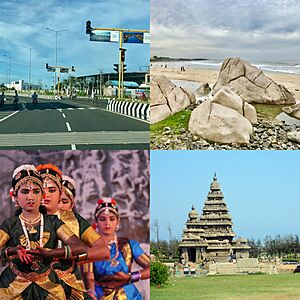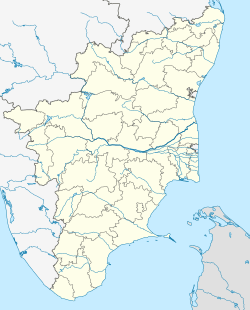Mamallapuram facts for kids
Quick facts for kids
Mamallapuram
Mahabalipuram
|
|
|---|---|
|
Suburban of Chennai city
|
|
| Mamallapuram | |

The town of Mahabalipuram
|
|
| Country | India |
| State | Tamil Nadu |
| District | Chengalpattu |
| Founded by | Kundavai Shiva |
| Elevation | 12 m (39 ft) |
| Population
(2011)
|
|
| • Total | 15,172 |
| Languages | |
| • Official | Tamil |
| Time zone | UTC+5:30 (IST) |
| PIN |
603104
|
| Telephone code | 91–44 |
| Vehicle registration | TN-19 |
Mamallapuram (also known as Mahabalipuram) is a town in the Chengalpattu district of Tamil Nadu, a state in southeastern India. It is famous for its ancient Hindu temples and monuments. These amazing structures were built in the 7th and 8th centuries and are now a World Heritage Site recognized by UNESCO.
This town is a very popular place for tourists to visit in India. Its old name was Thirukadalmallai. Mamallapuram is also part of the larger Chennai Metropolitan Area. It acts like a smaller town connected to the big city of Chennai.
Mamallapuram was once a very important port city for the Pallava dynasty. The town got its name from a Pallava king named Narasimhavarman I. He was also known as Mamalla. Because of its busy port, the town became rich. This wealth helped build many royal monuments. Most of these were carved right out of the rock.
These monuments date back to the 7th and 8th centuries. They include rathas (temples shaped like chariots) and mandapas (cave sanctuaries). You can also see a huge open-air rock carving called the Descent of the Ganges. The famous Shore Temple is also here, dedicated to the god Shiva. The way the town is set up today was planned by the British Raj in 1827.
Contents
What's in a Name?
The earliest mention of this city is found in a book from the 1st century. It was written by an unknown Greek sailor and is called Periplus of the Erythraean Sea. Later, a Greek geographer named Ptolemy called this place Malange.
Mahabalipuram is also known by other names. These include Mamallapattana and Mamallapuram. The name Mamallapuram means "the city of Mamalla." This was another name for the famous Pallava Emperor Narasimhavarman I. He ruled from 630 to 670 CE and built many of the famous temples here.
A famous saint named Thirumangai Alvar called this place Thirukadalmallai. He was talking about the Sthalasayana Perumal Temple in his writings. Sailors, even as far back as Marco Polo's time, knew Mahabalipuram as "Seven Pagodas." This name referred to the Seven Pagodas of Mahabalipuram that once stood by the sea. Today, only one of them, the Shore Temple, still stands.
A Glimpse into History
Scientists have found old burial urns and jars near Mahabalipuram. These items date back to the 1st century BCE. This shows that people lived here a very long time ago. An ancient poem from the Sangam age mentions a port called Nirppeyyaru. Experts believe this port is today's Mahabalipuram.
Old Chinese and Roman coins have also been found here. These coins show that Mahabalipuram was a busy trading center in ancient times. It connected India with other parts of the world. Two coins from the Pallava dynasty were also found. They had the names Srihari and Srinidhi on them.
The Pallava kings ruled Mahabalipuram from their capital city, Kanchipuram. They used the port for trade and to send messages to places like Sri Lanka and Southeast Asia. An 8th-century text describes the port as a "Sea Mountain." It says that ships full of wealth, elephants, and gems would anchor there.
The temples in Mahabalipuram tell stories from the Mahabharata, a famous Indian epic. Most of these temples were built during the rule of King Narasimhavarman I and his son Rajasimhavarman. They show how building styles changed over time. At first, temples were carved directly from rock. Later, they were built using cut stones.
The city of Mahabalipuram was founded by King Narasimhavarman I in the 7th century CE. The mandapas (pavilions) and rathas (shrines shaped like chariots) were carved from huge granite rocks. The famous Shore Temple, built later, was made from carefully cut stones.
Mahabalipuram is important because it shows how different ideas and styles influenced each other. The Shore Temple has many carvings. One carving is about 100 feet long and 45 feet high, carved from granite. In 1957, a college was started here to teach and keep alive the art of making sculptures and temples.
Getting Around
You can travel to and from Mamallapuram by bus. Bus services connect Mamallapuram with Chennai, Chengalpattu, Kancheepuram, and other nearby towns. There are both regular and air-conditioned buses available. Mahabalipuram is about 56 kilometers (35 miles) from Chennai.
Weather in Mamallapuram
Mahabalipuram has a tropical wet and dry climate. This means it has a hot season and a rainy season. The average temperature for the whole year is about 28.4 degrees Celsius (83.1 degrees Fahrenheit). May is usually the hottest month, with temperatures around 32.6 degrees Celsius (90.7 degrees Fahrenheit). January is the coolest month, with an average of 24.3 degrees Celsius (75.7 degrees Fahrenheit).
The amount of rain changes a lot throughout the year. There is much less rain in winter than in summer. The average rainfall for the year is about 1219 millimeters (48 inches).
Famous Landmarks
Mamallapuram is home to a collection of Hindu monuments from the 7th and 8th centuries. These have been named a UNESCO World Heritage Site. The town is located on the Coromandel Coast by the Bay of Bengal. It is about 60 kilometers (37 miles) south of Chennai, in Tamil Nadu, India.
The site has 40 ancient monuments and Hindu temples. One of the most famous is the Descent of the Ganges, also known as Arjuna's Penance. This is one of the largest open-air rock relief carvings in the world.
The monuments here include different types of structures:
- Ratha Temples: These are temples shaped like chariots. They were carved from single large pieces of stone between 630 and 668 CE.
- Mandapa Viharas: These are cave sanctuaries with halls and stone roofs. They show stories from the Mahabharata and other Hindu traditions.
- Rock Reliefs: These are carvings on rocks, especially bas-reliefs. They show scenes related to the gods Shiva and Vishnu.
- Stone-Cut Temples: These temples were built from cut stones. Many are dedicated to Shiva, but also honor Vishnu and other gods. They were built between 695 and 722 CE.
- Archaeological Finds: Digs have found old inscriptions, some from the 6th century or even earlier.
The cave temples and monolithic temples were built during the Pallava Dynasty. The Archaeological Survey of India takes care of this important site.
Some of the most important structures you can see are:
- Descent of the Ganges or Arjuna's Penance – a giant carving on an open rock face.
- Pancha Rathas (Five Chariots) – five pyramid-shaped structures. They are named after the Pandava brothers (Arjuna, Bhima, Yudhishtra, Nakula, Sahadeva) and Draupadi from the Mahabharata. Each one is carved from a single large stone.
- Cave Temples – more than ten temples carved into rocks. They date back to the 7th century. Some famous ones include the Varaha, Krishna, and Mahishasuramardini caves.
- The Shore Temple – a temple built right by the Bay of Bengal. You enter it from the side away from the sea. Recent digs have found new structures here.
- Other built temples like the Olakkanesvara temple and the lighthouse. Also, rock features like Draupadi's tank and Krishna's butterball.
- Thirukadalmallai, a temple dedicated to Lord Vishnu.
People of Mamallapuram
As of 2001[update] the census, Mamallapuram had a population of 12,345 people. About 52% of the population were males and 48% were females. The town has a good literacy rate of 74%. This is higher than the national average of 73%. For males, the literacy rate was 82%, and for females, it was 66%. About 12% of the people in Mamallapuram were under 6 years old.
Recent Events
In October 2019, the Prime Minister of India, Narendra Modi, and the President of China, Xi Jinping, visited Mamallapuram. They explored famous sites like Arjuna's Penance, the Pancha Rathas complex, and the Shore Temple.





